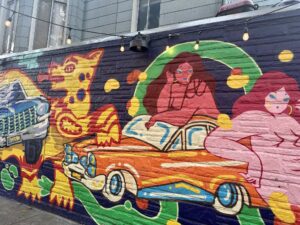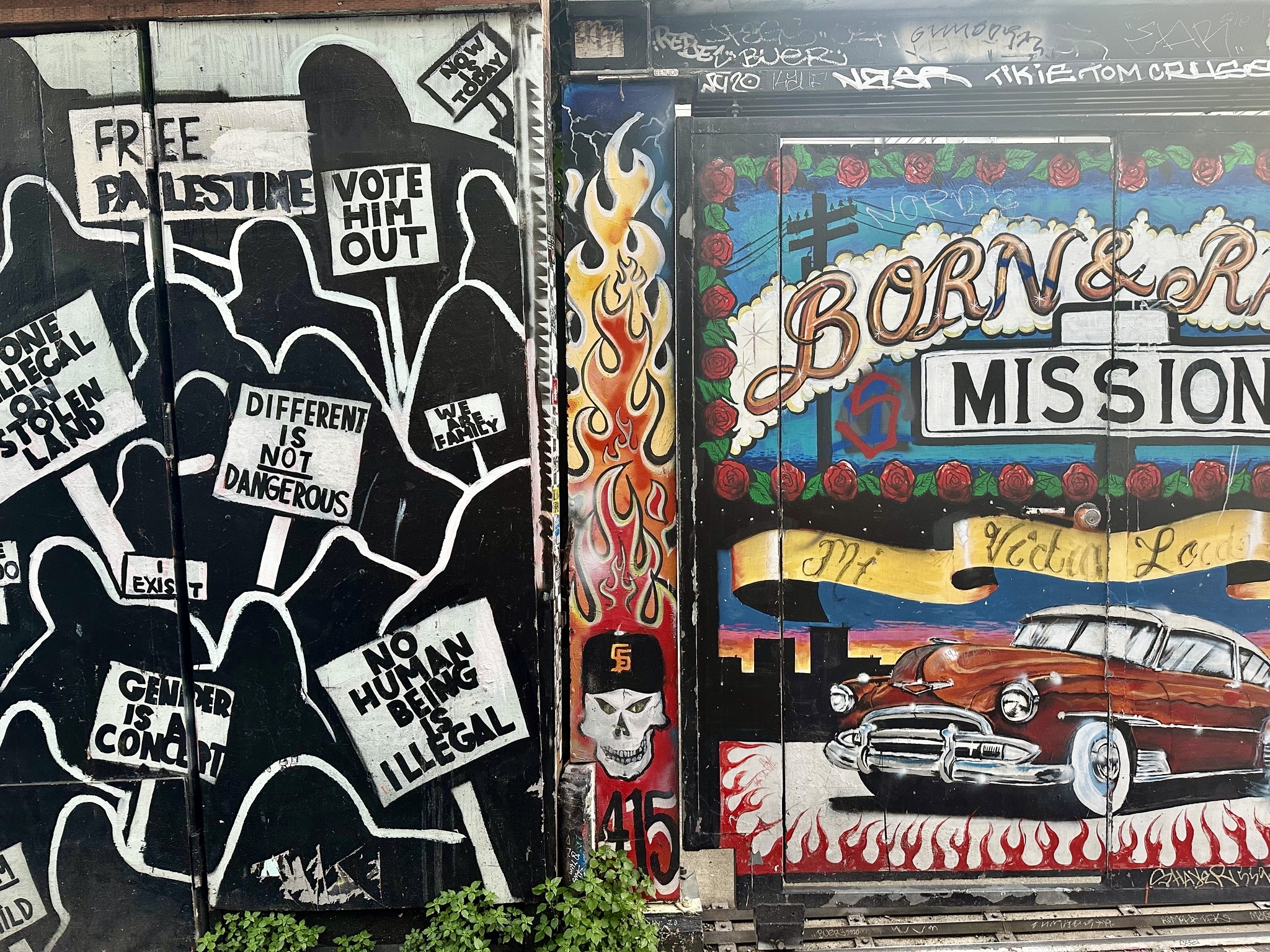Anyone who has taken a walk around San Francisco has likely been faced with a mural of some sort: perhaps a sprawling abstract work of art upon a garage door, the illustrated wall of a parklet, or even an alley covered fully in pieces with varying colors, messages and meanings. Taking root in the city’s bustling art scene and activist legacy, these larger-than-life works have grown to hold significant importance for the public as well as San Francisco itself.
In simple terms, a mural is “art on a surface,” Amanda Lynn, a mural artist who works around the Bay Area, said. Under this definition, murals are about as old as civilization, from the walls of ancient caves, to the painted stucco of ancient cities such as Teotihuacan, to the frescoes that decorate the walls and ceilings of Italian monuments.
Murals in San Francisco date back to the 18th century. However, their more modern successors take root in the tradition of Mexican muralists like Diego Rivera, who studied frescos in Italy and replicated their larger-than-life style in Mexico. His murals were on buildings and in public spaces, promoting revolutionary ideals to the masses in the wake of the Mexican Revolution. “When millions of peasants with low levels of formal education saw the murals, they could see themselves reflected in the art and therefore feel like they’re more connected to the nation that they fought for in the Mexican Revolution,” Lick-Wilmerding High School World History Teacher René Villicaña said. Eventually, Rivera would go on to paint murals in the U.S. as well, including in cities such as San Francisco.
Inspired by artists like Rivera, members of San Francisco’s Chicano Civil Rights movement in the 1960s took to the walls, painting murals meant to preserve and give voice to the Mexican, and more largely Latinx, community within the Mission District.

photo by Mira Krish
Since then, San Francisco’s Mission District has remained rich with this sort of thematically socio-political muralism. In places such as Clarion and Balmy Alleys, as well as others, murals cover every wall, garage door, and fence, telling stories about immigration, gender and sexuality inequities and much more.
Kelly Ording, a Bay Area-based artist, remarks on what it is like to paint amongst these murals. “It started, as political protest murals, or to speak about the history of Latinos in the neighborhood and women’s rights and all these things. [The Mission] has this history. And so it feels very different to paint [there],” she said.
Based on an activist legacy, mural art has grown to be much more, both in and out of the Mission. According to Annice Jacoby, author of Street Art San Francisco: Mission Muralismo, street art almost always falls under the umbrella of three different categories. “The first is provocative, which deals with the sledgehammer of aggression. The second one is protective, like during COVID when the stores were all shuttered, and you had plywood over them, there were many beautiful, comforting, nourishing [murals]. And the third is playful like Sirron Norris, or the Honeybear guy Fnnch,” she said.
Villicaña also sees the varied purposes of mural art. “Murals are a way to celebrate shared identity, they beautify public spaces in cities and uplift larger cultural themes that are important to a people,” he said.
Filled to the brim with so many different styles of murals and so many different artists, San Francisco has come to develop an energetic mural culture. “I think that’s the beauty of having all these different voices and different approaches to doing work out there. Otherwise, we’d all be a monolith. And that becomes really, really stagnant. That’s the antithesis of public education and public space,” Megan Wilson, an artist and co-director of the Clarion Alley Mural Project, said.

photo by Mira Krish
San Francisco has a sort of uniqueness for mural artists as well. “The culture [in San Francisco] is quite colorful and very accepting and because of that there’s a lot of unique talent that has come out of San Francisco and it’s kind of pushed the bar on the quality of artwork and interesting things people do,” Lynn said.
In fact, mural and public art is so important to San Francisco that in 1985, a program known as the “1% law” went into action, requiring that construction projects involving the creation of a new building or the addition of 25,000 square feet in Downtown spend 1% of their budget towards providing public art. This could mean anything from sculpture to mural work. In 2013, this program was amended to include costs for non-residential buildings in 15 zoning districts such as North Downtown, South of Market and the Dogpatch. This law has allowed many mural artists to remain working in what they love.
Obviously, there is importance in the history and culture of mural art; however, aside from that, what gives these works significance? Some murals give voice to communities, others tell stories. Ording, whose work is mainly abstract, sees another sort of importance. “We don’t need to be inundated with stories and messages all the time,” she said. “It’s nice to just give your brain a little break and be like ‘that is really beautiful’ and just call it at that,” she said.
At the end of the day, mural art is art for the public. Lynn said, “it’s unlike a painting where someone’s got to be invited into someone’s home or gallery to view it. A mural you can experience on your own in your own time and I just like that it’s somewhat of a gift to people that might not be expecting it.”
The best way to enjoy this gift and sample a multitude of stories, experiences, and energies? Step out of your house, walk down the street and look at a mural.








The Brand New Technology For Those Who Want To Be Incredibly Rich https://vipreg.pages.dev